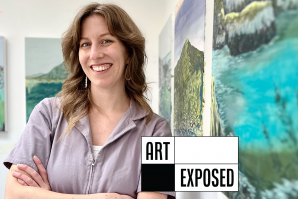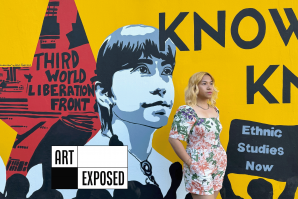Film and fiber artist Jamie Pesquiza Cardenas, together with fellow Capital Region artists Pachia Vang and Ren Allathkani, is working on a woven mural called “Threads of Belonging.” The project, incorporating Hmong, Filipino and Palestinian textile traditions and set to finish in the spring, will be accompanied by community workshops taking place this fall that respond to current immigration policies.
A grant from the Sacramento Office of Arts and Culture’s Creative Growth Fellowship Program helped Cardenas and her fellow artists realize this project. Built on recommendations from a recent city-commissioned report, the fellowship program is designed to allocate funds directly to artists and small collectives, representing a departure from institution-centric spending. (Disclosure: The writer is also a Creative Growth recipient.)
The Creative Growth grant allowed Cardenas to rent a shared studio where she could weave — previously, she had gotten rid of her dining room table in order to fit her loom in her living space. It also supports her views on direct support for artists. “We created a collective where we are taking back our voice,” Cardenas says. “It’s not just about grant funding and art shows, it’s deeper than that. It’s a form of mental health, healing for us, and of solidarity.”
Related: Cultural Capital: Who benefits from arts and culture in the Capital Region, and who owns it?
Across the country, arts funding models are shifting. Where once large institutions absorbed the majority of public and philanthropic support, new approaches are emphasizing direct investment in artists themselves.
Funding in crisis
“This is a life-changing opportunity for an artist like myself. I don’t consider myself just an artist; I’m a cultural steward, culture bearer, culture worker,” Cardenas says about the Creative Growth grant. “The shift of the funding coming back into our own hands cuts the middleman out. I believe what’s happening in Sacramento is these institutions are obscuring our voice. It’s exploiting our voice having to go through them.”
Cardenas supported the critiques of arts institutions that arose in the Sacramento region during the controversial evictions of textile artist Esther Marie Hall and visual artist Daniel Alejandro Trejo from Verge Center for the Arts in April 2024, leading to her own departure from Verge. While Verge and its board said that the reason for the evictions was backed by video footage, as CapRadio reported, several artists concluded that institutions need more artists with diverse backgrounds on boards and in decision-making roles in order to make equitable partnership and collaboration possible.
Cardenas quilts with fine fibers made of pineapple with film
negatives sewn into it.

Art organizations are also struggling with declining revenues and the clawback of government support. According to SMU DataArts, the National Center for Arts Research at Southern Methodist University, art organizations’ revenue fell 25 percent on average from 2023 to 2024.
Julie Baker, the CEO of Californians for the Arts, paints the picture of how oversubscribed traditional contribution channels are. “The California Arts Council received $89 million in eligible grant applications and had $19 million to award,” Baker says. “Public funding is strained at the state level. The resources are too low for how much demand and need is out there.”
Baker’s organization, a statewide arts advocacy nonprofit that provides programs and services to support the arts, is also tight on resources. “We manage the Performing Arts Equitable Payroll Fund for performing arts organizations with budgets of $2 million or less on behalf of the California office of the small business advocate CAL-OSBA to offset payroll increases in response to changes in employment laws such as AB 5,” she says, referring to the California law that sets standards for which workers qualify as independent contractors. “On day one we had more than 300 applications and shut it down after 10 days because it was first come, first served. By then, there were over $40 million in applications and $11 million to award.”
Related: How Sacramento Is Investing in Creativity
Adding to this strain is increased competition for donations. “Philanthropy is also trending away from arts and culture toward programs facing federal cuts, such as SNAP,” Baker says. “These are two disturbing trends. I’m hearing a lot of people talk about how they need to cut staff.”
Defining the artist class
The role of artificial intelligence adds urgency to these discussions. Many commercial jobs that once supported the “artist class,” such as illustration, design and copywriting, are being disrupted by AI tools. Meanwhile, independent artists are increasingly expected to manage their own audiences, marketing and business operations.
Collaborative projects like “Threads of Belonging” may allow artists to pool resources and share skills. “Someone once told me that Sacramento’s superpower is collaboration, and I see that more and more,” says Roshaun Davis, executive director of the Sacramento nonprofit CLTRE, via email. “In a time when resources feel tight, people are coming together, sharing ideas, and building collectively. That spirit of collaboration is shaping the economy right now, and it is what will allow us to compete on a global level.”
These kinds of investments move us closer to a future where creativity is not just supported, but recognized as a driving force in shaping Sacramento’s identity and economy.
Roshaun Davis, executive director, CLTRE
On direct-funding grants like Creative Growth, “It is good to see the grants go directly to creative entrepreneurs,” Davis says. “That type of investment builds culture and community while also laying the foundation for an economic infrastructure that allows Sacramento creatives to grow locally and compete nationally. These kinds of investments move us closer to a future where creativity is not just supported, but recognized as a driving force in shaping Sacramento’s identity and economy.”
Another resource-sharing option gaining interest among artists is “artist corporations,” promoted by Yancey Strickler, the co-founder of Kickstarter. Artist corporations would allow groups of artists to form legal entities that can access capital, provide benefits and manage shared resources. Advocates like Strickler argue that such structures could help stabilize creative workforces in the same way that cooperatives support other sectors.
Traditional arts organizations also have a role to play, as Davis and Baker of Californians for the Arts agree. “The trend I see is more recognition that collaboration is necessary,” Davis says. “Institutions bring stability and infrastructure. Creative entrepreneurs bring innovation and direct connection to people. When those strengths come together, the impact is stronger than either on its own.”
“We want to get to a place where this is not in poverty,” Baker says. “One of the concerns I always have is that we are pitted against each other. We need both artists and institutions. The idea that one or the other is more or less important is part of how we are less successful as a sector. We are often pitted against each other instead of unified, working together for a more equitable distribution of resources that also match the value and impact of what we bring to the community.”
–
Subscribe to the Comstock’s newsletter today.
Recommended For You

Cultural Capital
Who benefits from arts and culture in the Capital Region, and who owns it?
Some members of the arts sector experience instability due to a lack of ownership in the creative movements they build. A year out from pandemic reopenings, city and state programs are supporting artists in unprecedented ways — but the relief is temporary.

How Sacramento Is Investing in Creativity
Sacramento’s art and culture office seized a rare opportunity to splurge on economic development. Here’s how millions were spent
Sacramento’s Office of Arts and Culture, which traditionally
funded arts institutions such as theaters and museums, took
advantage of a windfall during the pandemic to help grow the
creative economy more broadly. Can the support last?

Art Exposed: Jennifer Peart
Meet the Sacramento artist painting portals to a sustainable future
Addressing themes of reciprocity and stewardship, Jennifer Peart’s artwork draws inspiration from science fiction novels, retrofuturistic architecture and pristine natural landscapes. Her intricate, vivid landscapes, often featuring familiar landmarks, are delicately painted on sustainably sourced wood panels.

Art Exposed: Julie Bernadeth Crumb
Weaving cultural memory and communal care into artistic practice
Whether creating elaborate jewelry inspired by pre-colonial harvest rituals, collaging woodcut prints into an altar homage to her Filipino homeland or sculpting clay into aquatic life forms for an underwater installation, award-winning multidisciplinary artist Julie Bernadeth Crumb uses her hands to forge materials into meditations on culture, identity and Indigeneity.



